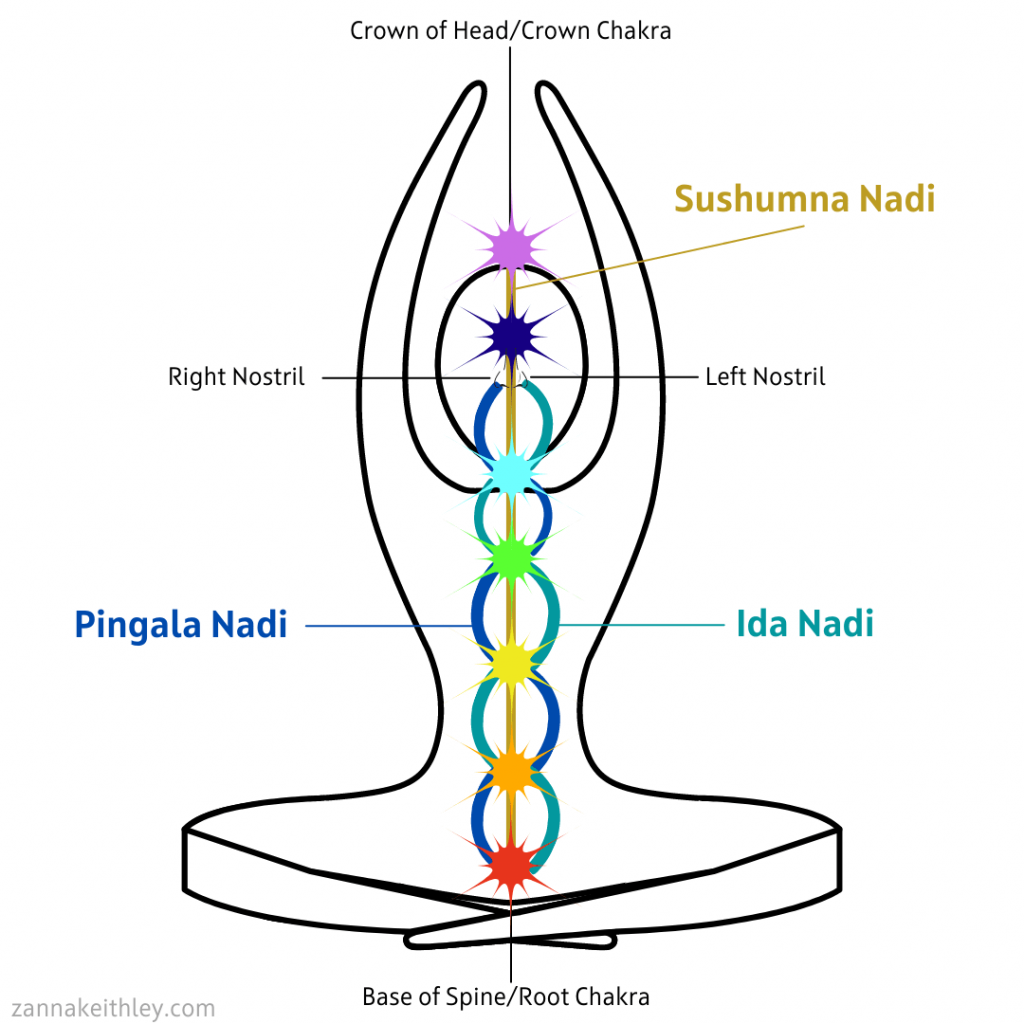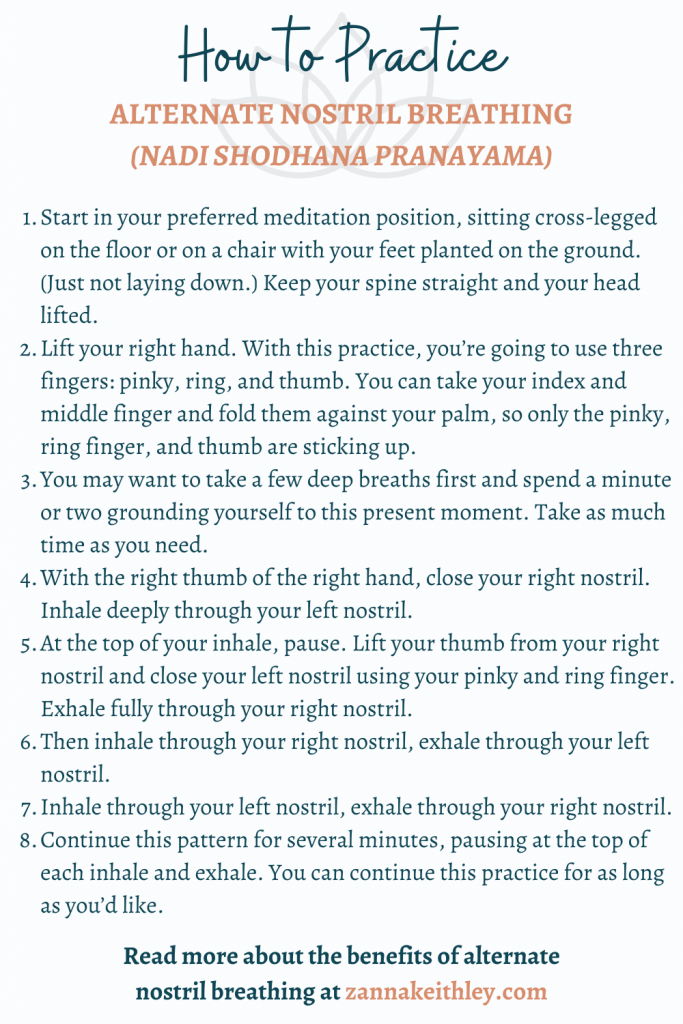-
Alternate Nostril Breathing Benefits & How-To Guide
In this article, discover the health benefits of alternate nostril breathing, a breath control practice in which you alternate inhaling and exhaling out of each nostril. You’ll also learn about the spiritual benefits of this practice and get a step-by-step guide on how to start today.

Pin this for later! Alternate Nostril Breathing (Nadi Shodhana Pranayama): Benefits & How-To Guide What is Alternate Nostril Breathing?
Alternate nostril breathing, also known as Nadi Shodhana or Nadi Shodhana Pranayama (translated to “subtle energy clearing breathing technique”), is a breath control practice commonly used in meditation and yoga. It’s often used as a way to clear blocked energy within your body as well as to cultivate a sense of calm and stillness within.
The practice of alternate nostril breathing is exactly as it sounds; it’s a breathing technique in which you alternate breathing in and out of each of your nostrils by closing off one of your nostrils with your fingers.
A typical practice might look something like this: close your right nostril and inhale through your left nostril. At the top of your inhale, switch and close your left nostril, exhaling out of your right nostril. Inhale through your right nostril, then close it and exhale out of your left nostril. Inhale through your left nostril, then close it and exhale out of your right nostril. Continue this pattern for the remainder of your practice.
Below, I’ll discuss this practice in greater detail. First, though, let’s look at the health benefits of alternate nostril breathing as well as the spiritual benefits of utilizing this powerful practice.
Health Benefits
So why practice alternate nostril breathing? Personally, I practice it as a way to calm my mind and ground myself to the present moment. When I sit down to meditate, I find it helpful to take a minute or two to practice alternate nostril breathing before I begin. This helps me to release distractions, clear my mind, and get centered as I start my meditation.
I also use alternate nostril breathing as a way to clear any blockages in my body’s energy channels, which I’ll discuss in more detail in the Spiritual Benefits section below.
Here are some of the commonly cited health benefits of alternate nostril breathing:
- Calms the mind
- Reduces anxiety
- Reduces stress
- Relaxes the body
- Improves cardiovascular function
- Improves lung function
- Promotes overall well-being
While the positive benefits of alternate nostril breathing have been promoted by yogis and meditation practitioners for years, there’s now some scientific evidence to back up these claims.
In this 2013 study, researchers found that those who practiced alternate nostril breathing showed a reduction in perceived stress levels and well as lower heart rates, respiratory rates, and blood pressure.
And in this 2017 study, researchers found that the practice of alternate nostril breathing (as well as other yogic breathing techniques) had a positive effect on respiratory endurance and the lung functions of competitive swimmers.
This 2018 review also shows how various yogic breathing techniques, including alternate nostril breathing, can be beneficial to one’s overall health and well-being.
If you have any questions about whether alternate nostril breathing could be helpful for you, please talk to your healthcare practitioner.

Spiritual Benefits
The spiritual benefits of alternate nostril-breathing can be linked to your chakra system, and more specifically, your nadis.
What are nadis? Nadis are the energy channels through which your life force flows; the word nadi is a Sanskrit word meaning “tube”, “channel”, or “flow.”
Many estimate that you have between 21,000 to 72,000 nadis in your body, though some believe there could be hundreds of thousands or even millions of nadis within each of us. Two of the most important nadis that you should know about are your Ida Nadi and your Pingala Nadi.
Your Ida Nadi is associated with your feminine energy and starts at the base of your spine (at your root chakra). It then runs through your core to your left nostril. It’s associated with right-brain dominance and what you might describe as your softer, darker energy.
Your Pingala Nadi is associated your masculine energy. It starts at the base of your spine (also at your root chakra) and runs through your core to your right nostril. (The Ida Nadi and the Pingala Nadi flow upwards criss-crossing each other at your chakra points.) It’s associated with left-brain dominance and what you might describe as stronger, lighter energy.
When your nadis become blocked, you may experience energy imbalances that can have negative effects on your physical, mental, emotional, and spiritual self. One way to clear energy imbalances is through alternate nostril breathing.
As you can see from the image above, your Ida Nadi runs through to your left nostril, and your Pingala Nadi runs through your right nostril. Alternate nostril breathing is a direct connection to these energy channels.
To know if either of these nadis might be blocked, you can do a quick test now. Gently press any of the fingers on your right hand against the right side of your nose, closing the right nostril. Place the fingers of your left hand below your left nostril. Exhale through your nose, noticing whether you can feel the warm air of your exhale against your left fingers. Then try this with your right nostril.
If you feel little or no air out of your left nostril, your Ida Nadi may be experiencing blockages. This represents your feminine energy, which is tied to surrendering, allowing, and just being.
If you feel little or no air out of your right nostril, your Pingala Nadi may be experiencing blockages. This represents your masculine energy, which is tied to hustling, achieving, and doing.
Neither side is more or less important than the other; when you find a balance between the two, you’re able to live your truest, most authentic life.
If you’re experiencing blockages to either of these energy channels, alternate nostril breathing can be a powerful tool to help clear these blockages.
However, I definitely encourage you not to stop there. It’s important to listen to your inner rhythm. For instance, if you’ve been in hustle mode for too long, your inner being may tell you it’s time to step back for a while and allow yourself to just be.
- You May Also Like: How To Create A Meditation Table (A Complete Guide)

Pin this for later! How to Practice Alternate Nostril Breathing
So are you ready to try alternate nostril breathing? Below, you’ll find step-by-step instructions to begin this powerful practice.
Please note that while my instructions have you starting out in a certain position, you don’t necessarily have to be in a meditation position to do this throughout the day. For instance, if you’re at work and want to practice alternate nostril breathing at your desk, that’s totally fine!
- You can start in your preferred meditation position, sitting cross-legged on the floor or on a chair with your feet planted on the ground. (Just not laying down.) Keep your spine straight and your head lifted.
- Lift your right hand. With this practice, you’re going to use three fingers: pinky, ring, and thumb. You can take your index and middle finger and fold them against your palm, so only the pinky, ring finger, and thumb are sticking up.
- You may want to take a few deep breaths first and spend a minute or two grounding yourself to this present moment. Take as much time as you need.
- With the right thumb of the right hand, close your right nostril. Inhale deeply through your left nostril.
- At the top of your inhale, pause. Lift your thumb from your right nostril and close your left nostril using your pinky and ring finger. Exhale fully through your right nostril.
- Then inhale through your right nostril, exhale through your left nostril.
- Inhale through your left nostril, exhale through your right nostril.
- Continue this pattern for several minutes, pausing at the top of each inhale and exhale. You can continue this practice for as long as you’d like.
As you continue to practice, try to follow your breath all the way from the base of your spine to your nostrils. Both your Ida Nadi and Pingala Nadi begin at the base of your spine and go through your left and right nostrils, respectively. Following the breath from the base of your spine through your nostrils allows you to connect with these energy channels, helping you to clear any blockages in either or both nadis.
Have you tried alternate nostril breathing? What benefits have you found through using breath control practices? Leave your comments and questions in the comment box below!
And for uplifting affirmations, chakra resources, meditation tools, self-love encouragement, and more, be sure to follow me on Pinterest and Instagram!
More Articles You May Like
- How to Protect Your Energy (7 Essential Practices)
- Sacred Self-Care For The 7 Chakras (A Complete Guide)
- Vision Board Ideas To Visualize Your Ideal Future (With Examples)
- 8 Powerful Guided Meditations For Manifesting Your Dreams
- 30 Journal Prompts For Self Growth (& Deeper Self-Love)

Pin this for later! Alternate Nostril Breathing (Nadi Shodhana Pranayama): Benefits & How-To Guide 
Zanna Keithley is an author, poet, and social media content creator who writes short prose dedicated to inspiring readers to follow their dreams, trust their intuition, and create beautiful and fulfilling lives. You can find her original writing on Instagram @zannakeithley.




